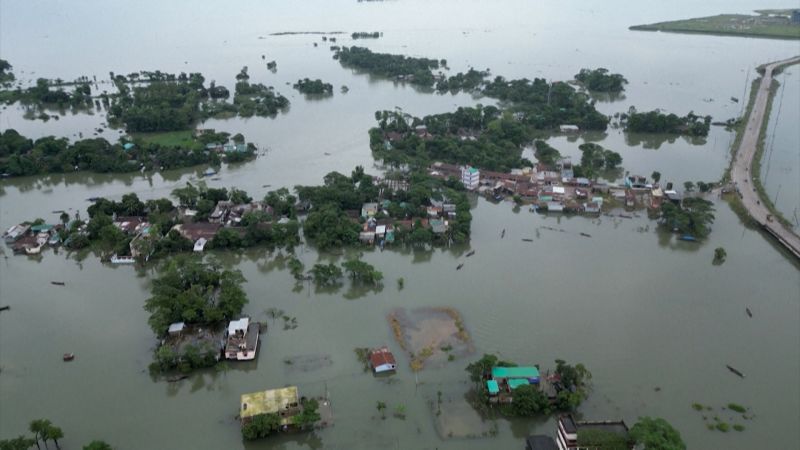The south Asian nation of Bangladesh, a country already known for its vulnerability to climate change, has been hit by another calamitous flood, the second in less than a month, leaving nearly two million people in dire straits. This new wave of devastating floods has affected an estimated 25 out of 64 districts in the country.
The rains started in late June, with the first wave of floods inundating a significant portion of northern and northeastern Bangladesh. This second wave, however, has struck with far greater intensity, impacting clusters of human settlements and agricultural fields that had narrowly escaped the first onslaught. The relentless natural disaster has left many trapped within their homes, struggling to survive amidst food shortages and the destruction of infrastructure.
The Bangladesh Flood Forecasting and Warning Centre (FFWC) announced that major rivers, including the Brahmaputra, the Ganges, and their tributaries, have swelled up beyond their danger levels. The hyperactive monsoon has led to drastic overspills, leading to widespread flooding and waterlogging, paralyzing life in both rural and urban areas.
From the affected population, it’s estimated that about 40% are children. With schools being damaged or underwater, studies are interrupted, plunging the future of thousands of students into uncertainty. In the same lines, health threats loom like an ominous shadow over those stranded due to lack of clean drinking water and proper medical aid. The COVID-19 pandemic accentuates these challenges as overcrowded relief camps and lack of social distancing measures threaten to turn flood-affected regions into virus hotspots.
Moreover, the repeated floods have rendered many people homeless and destroyed livelihoods. With the majority of Bangladesh’s population reliant on agriculture, the floods have wiped out vast tracts of farmland leading to a significant loss of crops. The loss of livestock is also a major concern, as many rural families depend on them for their survival.
Furthermore, the fragile infrastructure in Bangladesh has also taken a hit due to the floods. Roads, bridges, and other vital structures have been damaged, affecting the connectivity of many places. Power and communication lines are disrupted, further deepening the troubles of the stranded population.
Bangladesh’s authorities have mobilized resources to aid the affected, providing emergency relief to those in need. They are intensifying efforts to coordinate disaster management activities, like deploying rescue boats to evacuate stranded citizens, organising medical camps, and distributing food items.
As a low-lying deltaic country, Bangladesh perennially faces flood threats due to climatic factors and geographical positioning. Despite the country’s commendable adaptive measures and resilience over the years, the destruction caused by these back-to-back floods signifies the intensifying climate crisis that Bangladesh and similar nations continue to grapple with.
Significantly, the current floods highlight the harsh reality of climate change, reinforcing the urgency of international initiatives to combat this global crisis. Bangladesh’s struggle is a sobering reminder that the consequences of climate change are immediate and disastrous. It compels the global community to swiftly implement practical, preventative strategies and create climate-resilient societies.
The catastrophic flooding endured by Bangladesh is a pressing testament to unpredictable weather patterns induced by climate change. His calamity underscores the need for improved mitigation and preparedness strategies, not just for Bangladesh but globally, to ensure communities can better withstand such devastating natural disasters.




